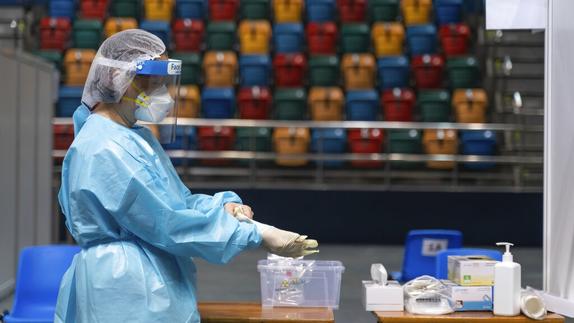 In this file photo, a medical professional puts on a pair of gloves at a makeshift testing site in the Queen Elizabeth Stadium in Hong Kong, Sept 1, 2020. (ANTHONY KWAN / POOL PHOTO VIA AP)
In this file photo, a medical professional puts on a pair of gloves at a makeshift testing site in the Queen Elizabeth Stadium in Hong Kong, Sept 1, 2020. (ANTHONY KWAN / POOL PHOTO VIA AP)
HONG KONG - The University of Hong Kong on Monday announced that a class of metallodrugs currently used in the treatment of other infectious diseases can potently suppress the SARS-CoV-2 virus that causes COVID-19.
According to researchers from the university, ranitidine bismuth citrate (RBC), a commonly used anti-ulcer drug which contains the metal Bismuth, has been demonstrated to greatly reduce viral loads by over 1,000-folds in SARS-CoV-2-infected cells.
According to researchers from the university, ranitidine bismuth citrate (RBC) has been demonstrated to greatly reduce viral loads by over 1,000-folds in SARS-CoV-2-infected cells
ALSO READ: HK sees 11 new virus cases, 4 testing centers now operational
In a golden Syrian hamster model, RBC suppressed SARS-CoV-2 replications to reduce viral loads by over 100 folds in both the upper and lower respiratory tracts, and mitigated virus-associated pneumonia.
In treating severe COVID-19 cases of infected hamsters, when compared to the group treated by Remdesivir, a broad-spectrum antiviral drug that has been reported to show efficacy towards SARS-CoV-2, and the control group, the animals treated by RBC showed remarkably lower level of prognostic markers and other major pro-inflammatory cytokines and chemokines.
Furthermore, RBC exhibited a low cytotoxicity with a high selectivity index at 975 as compared to Remdesivir which has a low selectivity index at 129. Concerning the cytotoxicity assessment, the larger the selectivity index number is, the safer the drug is.
READ MORE: Expansion of COVID-19 treatment facility completed
The researchers said the findings provide a new and readily available therapeutic option with high clinical potential for COVID-19 infections.
The study has been published in the online scientific journal Nature Microbiology. A related patent has been filed in the United States.


